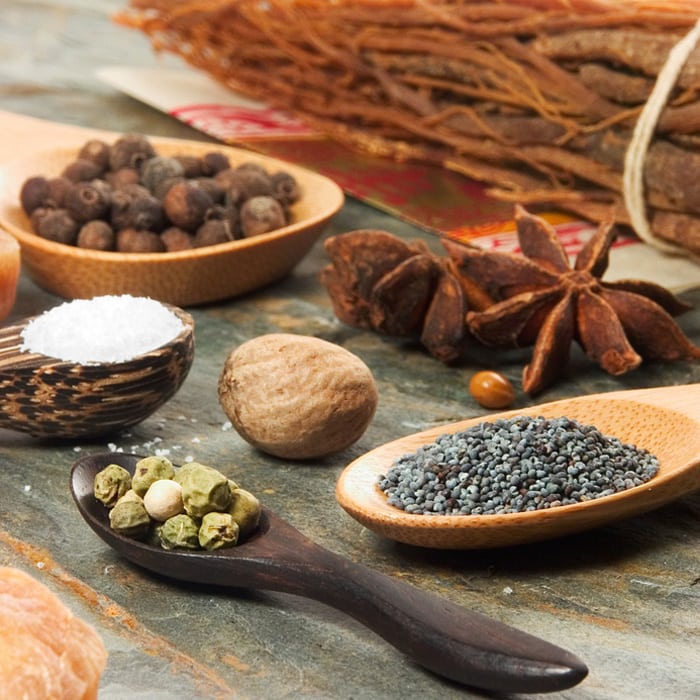
Written By: Owennie Lee, RD
Title: Registered Dietitian
Alumni: University of British Columbia
Last Updated on:

Foods like berries, dark-colored vegetables, and even dark chocolate come to mind when thinking about antioxidants. But did you know that many popular spices and herbs are actually amazing sources of antioxidants, too?

Table of Contents
The Oxygen Radical Absorbance Capacity (ORAC) is a scale developed by the National Institute on Aging in Baltimore, Maryland, to quantify the antioxidant capabilities of various foods. Although we do not yet know how high-ORAC foods actually function in the body, it allows us to compare antioxidant capabilities in foods. Spices actually have a much higher ORAC value per gram than most fruits and vegetables. For example, 1 teaspoon of cinnamon or cloves actually contains more antioxidants than half a cup of pomegranate juice!
| Food | Serving | ORAC
(umol TE per serving) |
| Cinnamon (ground) | 1 tsp | 6956 |
| Cloves (ground) | 1 tsp | 6199 |
| Pomegranate Juice | 1/2 cup | 5853 |
| Red Wine | 5 fl. oz | 5693 |
| Oregano (dried) | 1 tsp | 3602 |
| Turmeric (ground) | 1 tsp | 3504 |
| Blueberries | 1/2 cup | 4792 |
| Green Tea (brewed) | 1 cup | 2970 |
| Strawberries | 1/2 cup | 2969 |
| Parsley (dried) | 1 tsp | 1869 |
| Asparagus | 1/2 cup | 1441 |
| Red Grapes | 1/2 cup | 951 |
Cloves: This strong-flavored spice can be added sparingly to both savoury and sweet dishes to enhance flavor. For example, whole or ground cloves can be added to a variety of desserts, chai tea, and even to rice (to make Biryani, a pilaf-like rice dish in South Indian cooking) and broth. Cloves can also be paired with cinnamon to make desserts more interesting.
Cinnamon: Keep a shaker filled with cinnamon on hand to give your sweets a flavor boost. Sprinkle some in your coffee, dip your apples in a cinnamon-sugar mix, or add some to your cake and muffin recipes to maximize flavor and antioxidants.
Oregano: Tomato sauce, salads, and pizza comes to life when a dash of oregano is added. This Mediterranean herb can also be added to lemon-olive oil sauce, which goes well with grilled meat and fish dishes.
Turmeric: Tantalize your taste buds with this bright yellow peppery spice that is commonly found in curry powder blends. Turmeric can be used to add color and flavor to otherwise dull-looking food, such as chicken or egg salads and cauliflower.
Parsley: This versatile herb can be added to everything! It may be used in pesto sauce to enhance the green color, or sprinkled on egg dishes, soups, pasta, tomato sauces, and mashed potatoes. Meats benefit from a flavor boost when rubbed with a mixture of parsley, garlic, and lemon zest. Parsley can also be used as a garnish on almost any dish.
Although the concept of ORAC sounds promising, don’t put too much focus on it yet. IFT spokesperson Dr. Roger Clemens suggested that not much research has shown how high-ORAC foods actually function in our bodies. At this point, we only know these spices have high ORAC values, but we don’t know how much, how often, for how long we should be eating them. “Indeed, we don’t even know what high ORAC means to our bodies, and what clinical effects it provide to our health,” said Clemens, who is also a professor at the USC School of Pharmacy. Nevertheless, spices and herbs can liven up our food and help us cut down on salt and sugar. So don’t forget to keep a shaker or two of your favorite spices handy for a quick splash of flavor and antioxidants!
Alumni: University of British Columbia – Owennie is a registered dietitian with a soft spot for chocolate and coffee. She is a believer in balance and moderation, and is committed to keeping healthy eating enjoyable and fun. Owennie received her dietetics training in Vancouver, and is a member of Dietitians of Canada and the College of Dietitians of British Columbia. She has experience in a wide variety of settings, such as clinical nutrition, long-term care and outpatient counseling. Owennie has also worked for a community nutrition hotline and participated regularly as a guest radio host, where she enjoyed sharing her passion and knowledge about food and nutrition with people.
antioxidant, cancer diet, diabetes diet, healthy snacks, heart smart, herbs, orac, spices